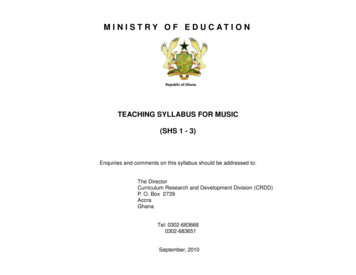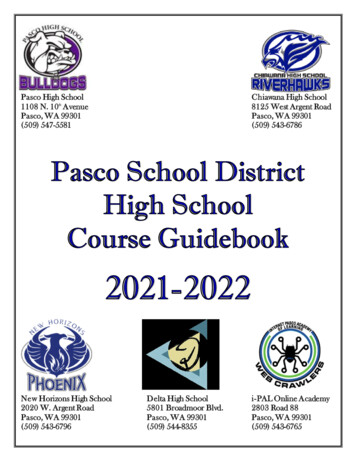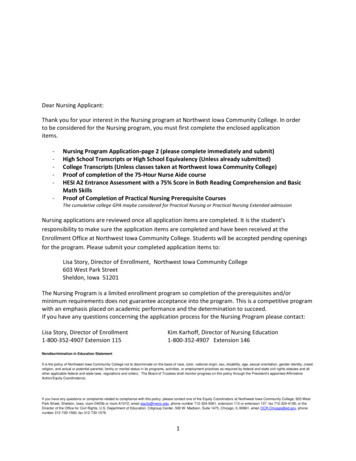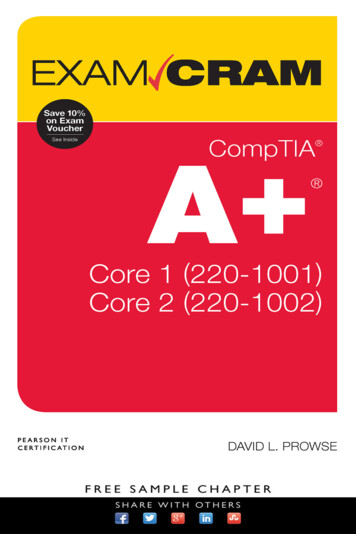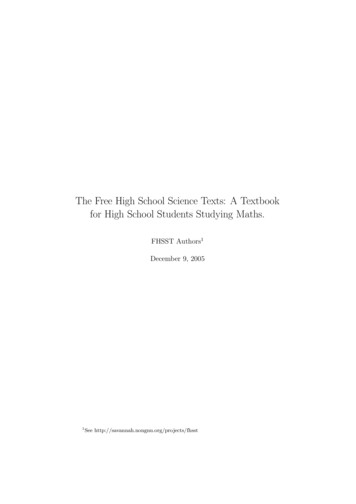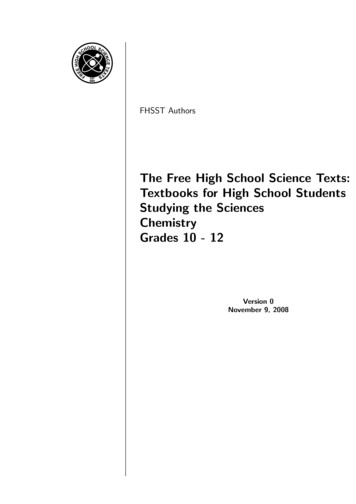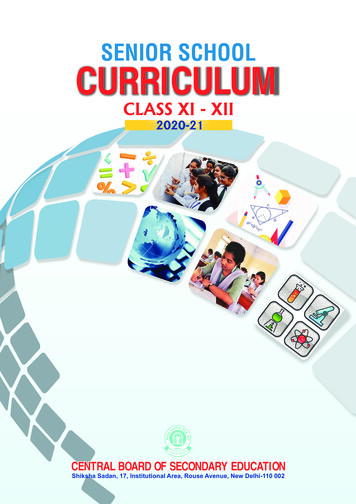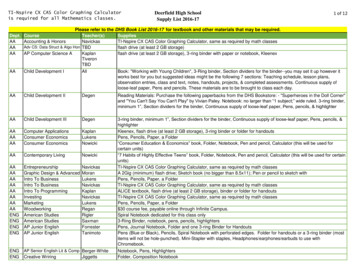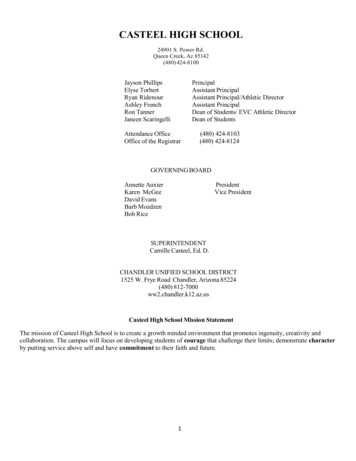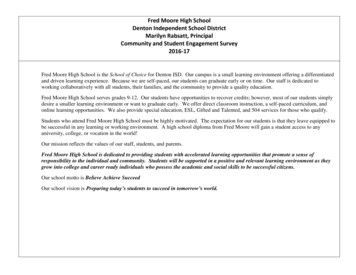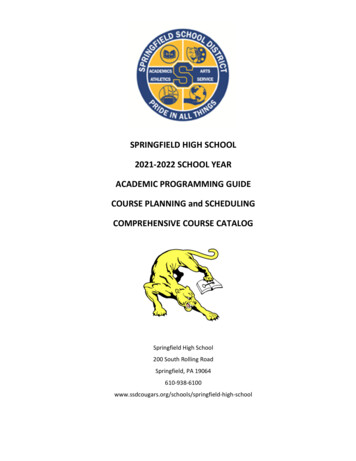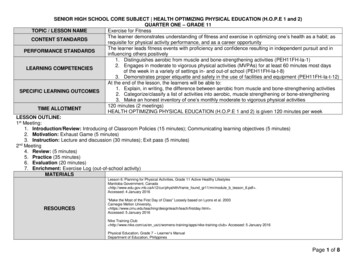
Transcription
SENIOR HIGH SCHOOL CORE SUBJECT HEALTH OPTIMIZING PHYSICAL EDUCATION (H.O.P.E 1 and 2)QUARTER ONE – GRADE 11TOPIC / LESSON NAMEExercise for FitnessThe learner demonstrates understanding of fitness and exercise in optimizing one’s health as a habit; asCONTENT STANDARDSrequisite for physical activity performance, and as a career opportunityThe learner leads fitness events with proficiency and confidence resulting in independent pursuit and inPERFORMANCE STANDARDSinfluencing others positively1. Distinguishes aerobic from muscle and bone-strengthening activities (PEH11FH-Ia-1)2. Engages in moderate to vigorous physical activities (MVPAs) for at least 60 minutes most daysLEARNING COMPETENCIESof the week in a variety of settings in- and out-of school (PEH11FH-Ia-t-8)3. Demonstrates proper etiquette and safety in the use of facilities and equipment (PEH11FH-Ia-t-12)At the end of the lesson, the learners will be able to:1. Explain, in writing, the difference between aerobic from muscle and bone-strengthening activitiesSPECIFIC LEARNING OUTCOMES2. Categorize/classify a list of activities into aerobic, muscle strengthening or bone-strengthening3. Make an honest inventory of one’s monthly moderate to vigorous physical activities120 minutes (2 meetings)TIME ALLOTMENTHEALTH OPTIMIZING PHYSICAL EDUCATION (H.O.P.E 1 and 2) is given 120 minutes per weekLESSON OUTLINE:1st Meeting:1. Introduction/Review: Introducing of Classroom Policies (15 minutes); Communicating learning objectives (5 minutes)2. Motivation: Exhaust Game (5 minutes)3. Instruction: Lecture and discussion (30 minutes); Exit pass (5 minutes)nd2 Meeting4. Review: (5 minutes)5. Practice (35 minutes)6. Evaluation (20 minutes)7. Enrichment: Exercise Log (out-of-school activity)MATERIALSLesson 6: Planning for Physical Activities, Grade 11 Active Healthy LifestylesManitoba Government, Canada http://www.edu.gov.mb.ca/k12/cur/physhlth/frame found gr11/rm/module b lesson 6.pdf .Accessed: 4 January 2016RESOURCES“Make the Most of the First Day of Class” Loosely based on Lyons et al. 2003Carnegie Mellon University, stday.html .Accessed: 5 January 2016Nike Training Club http://www.nike.com/us/en us/c/womens-training/apps/nike-training-club Accessed: 5 January 2016Physical Education, Grade 7 – Learner’s ManualDepartment of Education, PhilippinesPage 1 of 8
SENIOR HIGH SCHOOL CORE SUBJECT HEALTH OPTIMIZING PHYSICAL EDUCATION (H.O.P.E 1 and 2)QUARTER ONE – GRADE 11PROCEDUREMEETING LEARNERS’ NEEDSINTRODUCTION (20 minutes)The importance of the First Day of Class:Since this is the first day of class, it is1. Introduce yourself to the classstrongly recommended that a few minutes2. Present and clarify the course’s learning objectivesis invested on proper introduction, levelling3. Help students learn about each otherof expectations and getting a sense of who4. Set the tone for the course. You are encouraged to show your students the course schedule.your learners’ are (prior knowledge and5. Collect baseline data on students’ knowledge and motivation on the coursemotivation)6. Stir students’ interest for the course content7. Inform students of course requirementsReview of the Junior High School PECurriculum: To understand where thestudents are coming from, review the JHSPE curriculum available for viewing anddownload at the DepEd WebsiteMOTIVATION (5 minutes)1. Tell the students to get their notebooks.2. Instruct them to describe what physical fitness is, using their own words. Writer their answerson their notebooks.Sample question: In your own understanding, what is physical fitness?Physical Fitness is For me, physical fitness is about Room for differentiation: If students find the previous question too challenging, do any of the ff:a) Describe a person who is physically fit. How do you know that a person isphysically fit? What can he do? What does he eat?b) You may also ask them to react to this quote by Jim Rohn – “Take care of your body, it isthe only place you have to live.”c) Or ask your students – What comes to your mind when you see/hear/read “PhysicalFitness?”Sample responses for option Cexercise, sportsfood, dietbody,thin, fat, sexywell-being, healthlifestylekalusugankatawanDebunking myths and assumptions: Beready with answers such as “Thinness isequated with healthiness” or “those whomaintain a vegan diet is automaticallyhealthier than those who don’t.”Consider choice of words: Words such as“thin” or “fat” may be used in class. This maybe an opportunity for discrimination. Beready to infuse values on respect.3. Think-pair-share: Tell the students to find a partner, preferably their seatmate for convenience,and share their answers.Page 2 of 8
SENIOR HIGH SCHOOL CORE SUBJECT HEALTH OPTIMIZING PHYSICAL EDUCATION (H.O.P.E 1 and 2)QUARTER ONE – GRADE 11INSTRUCTION (30 minutes)1. Post on the board the following definitions of Physical Fitness:Review: The topics for the lesson werea) Physical Fitness is a state of good health and well-being of an individual (K to 12 Grades 1 already introduced during JHS (Grade 7to 10 Curriculum, Glossary of Terms)and 8). It is assumed that this is just ab) Physical Fitness is “a set of abilities that one possesses in order to perform physicalreview for the students.activities.” (Centers for Disease and Prevention, 1985; Grade 7 Teacher’s Guide – Session1, Module 1)2.Process your students’ responses from the motivation activity. Connect it with the definition ofphysical fitness.3.Transition to the three components of physical fitness. Recall and review the three componentsof fitness by posting the definitions on the board. Call students to match the definitions with thecorresponding component.a) Health-related physical fitness( HRPF) consists of specific components that have arelationship with good health, or a lower risk of illness.HRPF includes: body composition, cardiovascular endurance, flexibility, muscularendurance and muscle strengthb) Skill-related physical fitness (SRPF) pertains to components related with learning motorskills quickly and ability to achieve high level of performance in sports.SRPF includes: agility, balance, coordination, power, reaction time and speedFor Participation Purposes:Encourage your students to revisit theirJunior High School notes. You can also askthem to bring their notes from Junior HighSchool to classAgain, this is just a review of their JHSlessons.For visual purposes: it would help to havean instructional material for the componentsof fitness. (i.e. chart, chalk work, hand-outs,etc)c) Physiological Fitness relates to biological systems that are influenced by one’s level ofhabitual physical activityPhysiological Fitness includes: Metabolic Fitness (MetF), Morphological Fitness (MorF)and bone integrity (BI)Source: Grade 7 Learner’s Material, DepEd4.Emphasize that as humans, we have the power to shape and influence our physical fitness.The three components of physical fitness can be directly affected by our diet (what we eat) andthe amount of physical activity we do.Page 3 of 8
SENIOR HIGH SCHOOL CORE SUBJECT HEALTH OPTIMIZING PHYSICAL EDUCATION (H.O.P.E 1 and 2)QUARTER ONE – GRADE 115.EXHAUST ACTIVITY: After knowing the components of physical fitness, it is now time toreflect on one’s fitness. In two minutes, instruct the students to write all the physical activitiesthat they perform regularlySample responseswashing the dishessweeping the floorironing the clotheswalking to schoolwatering the plantsfetching a pail waterlifting weightsplaying sportsdancing6. Discuss what physical activities are:a) Any bodily activity that enhances or maintains physical fitness, health and wellnessb) Any bodily movement produced by skeletal muscles that requires energy expenditureOn the activity’s instruction: There is aprobability that students would ask andclarify what type of physical activity they canwrite – from the daily activities like walking,washing the dishes, sweeping the floor,etc., to sports like basketball and swimming.At this point, refrain from answering thequestion. This would serve as a gauge ofwhat students consider as physicalactivities.7. Inform the students that you would be referring to their answers in the latter part of theperiod8. Go on to review the types of physical activities. Ask your students for the three types ofphysical activities. You may also post them on the g9. Tell your students to refer to their answers in #5 (Exhaust Activity). On their notebooks, instructthem to categorize their answers into aerobic, muscle-strengthening and bone-strengthening,based on their previous knowledge.10. After a few minutes, call for volunteers to write their answers on the board.11. Discuss and differentiate aerobic, muscle-strengthening and bone-strengthening activities area) AEROBIC – moves your large muscles, such as those in your arms and legs. Aerobicactivities make your heart best faster than usual. Regular aerobic activity strengthens yourheart and lungs.Examples: walking, running, swimming, bicycling, dancing, sports such as basketball andsoccer,Encourage questions: At this point,encourage your students to ask questionsand share their thoughts.b) MUSCLE-STRENGTHENING – improves strength, power and endurance of muscles.Examples: doing push-ups, pull-ups and sit-ups, lifting weights, climbing the stairs,digging the gardenPage 4 of 8
SENIOR HIGH SCHOOL CORE SUBJECT HEALTH OPTIMIZING PHYSICAL EDUCATION (H.O.P.E 1 and 2)QUARTER ONE – GRADE 11c) BONE-STRENGTHENING activities – helps your bones grow and keeps them strong.When your feet or arms support your body’s weight, and your muscles push against yourbones, these are bone-strengthening activities.Example: jumping, skipping, hopping12. After the discussion, ask your students’ to check if they grouped their answers accurately.Exit Pass (10 minutes)13. On a sheet of paper, answer the following questions:a) Of the three components of fitness, in what area do you need to improve the most? How doyou plan to improve on them?b) Which type of physical activity are you most comfortable with?c) Do you consider yourself physically fit?d) What do you want to learn during this course?Get to know your students:This exit pass provides you with additionaldata on your students. Get to know them soyou may design your lessons around theirneeds and interests.14. Collect their work.15. Remind your students to come in their PE uniform for the next meeting.Take home activity – important16. Ask your students to answer the following: (pre-exercise screening tool)a)b)c)d)e)f)g)h)Has your doctor ever said that you have a heart condition and that you should only dophysical activity recommended by a doctor?Do you feel pain in your chest when you do physical activity?In the past month, have you had chest pain when you were not doing physical activity?Do you lose your balance because of dizziness or do you ever lose consciousness?Do you have a bone or joint problem (for example, back, knee, or hip) that could be madeworse by a change in your physical activity?Is your doctor currently prescribing drugs (for example, water pills) for your blood pressureor heart condition?Do you know of any other reason why you should not do physical activity?Safety precautions:Before starting with the physical activities,ensure the health condition of your studentsSecure parent’s/guardian permit and/or adoctor’s health certificate from all yourstudents before they engage in theactivities.Page 5 of 8
SENIOR HIGH SCHOOL CORE SUBJECT HEALTH OPTIMIZING PHYSICAL EDUCATION (H.O.P.E 1 and 2)QUARTER ONE – GRADE 112nd MeetingINTRODUCTION AND REVIEW (10 minutes)1. Ask your students to give a recap of the previous lesson.2. Ask for someone to define physical fitness, aerobic, muscle and bone-strengthening activities.3. Ask for the difference between aerobic, muscle and bone-strengthening activites.4. Present and clarify the learning objectives for this session.For today we will:a) Engage in moderate to vigorous physical activities (MVPAs) for at least 60 minutes mostdays of the week in a variety of settings in- and out-of school (PEH11FH-Ia-tb) Demonstrates proper etiquette and safety in the use of facilities and equipment (PEH11FHIa-t-12)At the end of the class we will:a) Have an evaluation for this lessonPRACTICE (35 minutes)1. Lead the class to the activity area – gym, basketball court, open space.2. Instruct the students to form X lines (where X depends on the class size and available space)3. Before starting the exercise, ask the students for etiquette and safety reminders.4. Do the warm-up first, the work-out proper, then the cool down1 WARM-UP3 COOL DOWNActivityTimeActivityTimeLight jog (A)Back pedal (A)2 min1 minActivityCobra (stretching)Pretzel stretch (stretching)Lower back stretch (stretching)Standing hamstring stretch (stretching)2 WORK-OUT PROPERTimekick downs (MS)modified pus-ups (MS)modified plank (MS)froggers (A, BS)side lunge (MS)recover/rest2 feet forward/backwards hops in place (A, BS)Plank (MS)Squats (MS)abdominal curls (MS)recover/restopposite arm/leg extension (MS)2 min1 min30 sec1 min1 min30 sec30 sec1 min1 min1 min30 sec1 minActivity2 feet lateral hops in place (A, BS)Modified tricep push-ups (MS)Alternating step back lunges (MS)RecoverJumping jacks (A, BS)Abdominal curls (MS)Modified push-ups (MS)RecoverModified plank (MS)Burpees (A, BS)Squat hold (MS)Shoulder press (MS)30 sec1 min1 min2 minTime30 sec30 sec30 sec30 sec15 sec1 min1 min30 sec30 sec1 min15 sec1 minYou may opt to assign someone to give theprevious lesson’s review ahead of time. Ifyou would permit, you may also let themrefer to their notes.For etiquette and safety reminders:1. Wear the right attire2. Use the appropriate equipment3. Warm-up before the working4. Cool down after the workout5. Stay hydrated6. Breathe throughout the exercise7. Listen to your body – know when tokeep pushing yourself and when to stopDuring the work-out proper:Ask the students to identify if the exerciseis aerobic (A), muscle (MS) or bonestrengthening (BS)Page 6 of 8
SENIOR HIGH SCHOOL CORE SUBJECT HEALTH OPTIMIZING PHYSICAL EDUCATION (H.O.P.E 1 and 2)QUARTER ONE – GRADE 11EVALUATION (15 to 20 minutes)1. Go back to the classroom and start with the evaluation.A. Essay1. Instruct the students to answer the following questions:a) Differentiate aerobic activity from muscle and bone-strengthening activity in terms of itseffect to your bodyb) Describe the benefits of aerobic, muscle and bone-strengthening activitiesc) Explain the importance of aerobic, muscle and bone-strengthening activities2. Tell the students to answer the questions through a one-page essay. Make theiranswers as complete and as concise as they can.3. Inform the students of the rubric for grading (See annex A) and the allotted time for the activity.4. Ask the students if there are any clarifications before starting the activity.B. Personal inventory of monthly physical engagements (not graded)1. Tell the students to assess their monthly physical engagement (moderate to vigorous physicalactivity) by answering the following questions:a) FREQUENCY: How often do you engage in such activity/ies?b) INTENSITY: How hard/intense do you exercise?c) TIME: How long do you engage in the activity/ies?d) TYPE: What physical activity/ies do you engage yourself in?2. Instruct the students to use the FITT Principle to organize their answers.FREQUENCY (F)INTENSITY (I)TIME (T)daily, x toy times a weeklight, moderate, vigorousx minutesGiving clear directionsTo check if the students understood thespirit of the question, you may ask them torephrase the question in their own wordsExample: What does aerobic activity do tomy body? What is its effect to me?Be strict with the maximum of one-pageoutput. This would help improve thestudents’ writing and communication skills.Review the FITT principleThe FITT principle has been introducedduring Junior High School (Grade 7 and 8).This personal inventory will be collected butnot graded. This would serve as anotherdata source about the students.TYPE (T)activity3. Collect the students’ worksENRICHMENTInterval Training1. During your free time, outside school, try interval training. Interval training is when you varyyour speeds and intensity throughout a shorter run.2. Sample interval running schedule:a) 5 minutes of warmup: light walking, to jog then stretch.b) 30 seconds of increased pace (70% of maximum effort) 2 minutes of decreased pace.c) 30 seconds of increased pace (75% of maximum effort) 2 minutes of decreased pace.d) 30 seconds of increased pace (80% of maximum effort) 2 minutes of decreased pace.This would be a good pre-activity forthe next topic on energy systemsA) ATP-PC (high power, short duration)B) glycolytic (moderate power/shortduration),C) oxidative (low power/long duration)Page 7 of 8
SENIOR HIGH SCHOOL CORE SUBJECT HEALTH OPTIMIZING PHYSICAL EDUCATION (H.O.P.E 1 and 2)QUARTER ONE – GRADE 11e) 30 seconds of increased pace (85% of maximum effort) 2 minutes of decreased pace.f) 30 seconds of increased pace (90% of maximum effort) 2 minutes of decreased pace.g) 30 seconds of increased pace (100% of maximum effort).2 minutes of decreased pace.h) 5 minutes of light jogging and stretching.3. The pace would be different for each person. If you’re really out of shape, your 120 secondsmight be walking, and your 30 seconds might be jogging. If you are in shape, your 120seconds might be jogging and your 30 seconds might be sprinting.4. Take note of your experience. Keep track of your heartrate, throughout the interval training.Suggested rubric for the essay evaluationBeginning0 ptsContent10 ptsDid not answer question.Beginning0 ptsOrganization10 ptsDid not answer question.Beginning0 ptsWriting Conventions5 ptsDid not answer question.Developing4 ptsAnswers are partial orincomplete. Key pointsare not clear. Questionnot adequatelyanswered.Developing4 ptsOrganization andstructure detract fromthe answer.Developing2 ptsDisplays over five errorsin spelling, punctuation,grammar, and sentencestructure.ApproachingProficiency6 ptsAnswers are notcomprehensive orcompletely stated. Keypoints are addressed,but not well supported.ApproachingProficiency6 ptsInadequate organizationor development.Structure of the answeris not easy to follow.ApproachingProficiency3 ptsDisplays three to fiveerrors in spelling,punctuation, grammar,and sentence structure.Proficient8 ptsAnswers are accurateand complete. Keypoints are stated andsupported.Proficient8 ptsOrganization is mostlyclear and easy to follow.Advanced10 ptsAnswers arecomprehensive,accurate and complete.Key ideas are clearlystated, explained, andwell supported.Advanced10 ptsWell organized,coherently developed,and easy to follow.Proficient4 ptsAdvanced5 ptsDisplays one to threeerrors in spelling,punctuation, grammar,and sentence structure.Displays no errors inspelling, punctuation,grammar, and sentencestructure.Page 8 of 8
SENIOR HIGH SCHOOL CORE SUBJECT HEALTH OPTIMIZING PHYSICAL EDUCATION (H.O.P.E 1 and 2) QUARTER ONE – GRADE 11 Page 3 of 8 INSTRUCTION (30 minutes) 1. Post on the board the following definitions of Physical Fitness: a) Physical Fitness is a state of good health and well-being of an indiv
